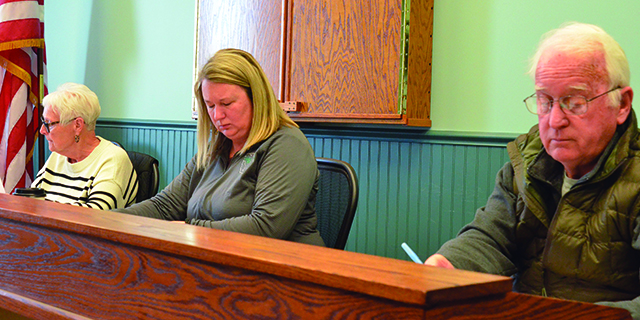Gekeler family connects with its remarkable past at reunion
Published 3:39 pm Tuesday, July 28, 2009

- Several people role-played pioneers in the Grande Ronde Valley during the Gekeler Family Reunion Saturday at Fred Beeman Park. Those who did include, from left, Carol Summers, Becky Gekeler, Avery Stanton and Donna Dee (Smutz) Clark. - The Observer/DICK MASON
A family that survived a Grande Ronde Valley winter in a tent made of bed sheets and a woman who walked the Oregon Trail barefoot.
Amazing tales from Ripley’s Believe It Or Not?
No, but these are tales from the Gekeler family’s story, ones integrally linked to the founding of the Grande Ronde Valley.
It is a story that will continue to live long after the final Oregon Trail rut disappears. One celebrated again Saturday at the Gekeler Family Reunion. A total of 179 people attended the reunion, many of whom left with a renewed appreciation of the significance their family had in helping settle the Grande Ronde Valley.
“Our family has a history we all feel an identity with, one it is a real privilege to be a part of,” said Irwin Smutz of La Grande, who is closely related to the Gekelers.
The family’s well-documented legacy started here on Sept. 13, 1862, when George and Catherine Gekeler arrived after traveling here from Falls City, Neb., on the Oregon Tail with a wagon train.
The Gekelers were low on provisions and worried that they would not be able to make it over the Blue Mountains before winter. They decided to remain in the Grande Ronde Valley, which other members of their wagon train also did.
The Gekelers did not have time to build a cabin so they put up a tent made of bed sheets. The primitive tent, put up at what is today 2811 Gekeler Lane, was good enough for the family to survive because the Grande Ronde Valley experienced a mild winter in 1862-63, said Carol Summers of La Grande, one of the reunion’s organizers.
The winter was hard on Catherine Gekeler, though. She had no shoes.
“Her feet froze,” said Carole Smutz of La Grande, a reunion organizer.
Catherine Gekeler’s feet must have had thick callouses because she walked most of the Oregon Trail barefoot since she did not want to wear out her shoes before her family reached its destination. Unfortunately she lost her shoes before she reached Oregon, said Barbara Smutz of La Grande who has compiled a written history of the Gekeler family.
George and Catherine Gekeler traveled to Oregon with an infant son, William, a baby who was not the silent type.
“He cried only once. He started in Nebraska and didn’t quit until he got to Oregon,” Carole Smutz said.
Many in the wagon train the Gekelers traveled here with may have come because they wanted to avoid fighting in the Civil War.
“One of the reasons many (settlers in the early 1860s) came was because of the Civil War. They had a choice. They could fight in the Civil War or go on the Oregon Trail. Both were equally dangerous,” Irwin Smutz said.
Catherine Gekeler found herself without her husband during her family’s initial year here because George traveled to The Dalles to pick up provisions for the community here. The journey to The Dalles and back took several months.
George Gekeler probably did not pick up butter during his journey because it was not needed, according to family records. His wife made some of the best butter around. It was so good that that Indians sometimes stole it from her home. Outside of this the Gekelers had a good relationship with Indians in the region.
Settlers also had good relationships with one another. Trust was implicit. Deals were sealed with handshakes, not legal documents.
An example involved an 1800s land deal between two farmers, I.D. Smutz of Sandridge Road near Cove and a farmer on Foothill Road.
“They traded farms on a handshake late at night,” Carole Smutz said.
The swap was made because I.D. Smutz’s wife, Dora Gekeler wanted to return to La Grande to be near her sisters. Still, the move tugged at Dora’s emotions.
“She cried for most of the way to La Grande because she knew she would never see her house again,” Carole Smutz said.
She knew this because traveling the approximately 10 miles between Sandridge Road and Foothill Road was slow and difficult before the days of trains and automobiles.
The railroad did not come to the Grande Ronde Valley until 1884. Its arrival was responsible for another incident that is a part of the Gekeler family’s lore. A horse owned by Charles Gekeler, a son of George and Catherine, was so shocked when it saw a train for the first time “… that he fell over and died,” Carole Smutz said.
The tale is one of a seemingly infinite number of stories involving the Gekeler family history.
“So run pioneer tales in the Grande Ronde Valley. Many trials, a bit of fun, and honest hard work have grown into a happy and busy community life,” reads a passage in the Gekeler Family Reunion book.
Saturday’s reunion was conducted at Fred Beeman Park in Island City. Organizers like Barbara Smutz seemed to look upon the many hours of work needed to put the reunion as no bother at all.
“It was worth it to watch people enjoying themselves while being together again,” she said.





